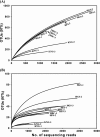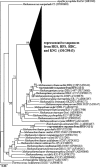Comparative survey of rumen microbial communities and metabolites across one caprine and three bovine groups, using bar-coded pyrosequencing and ¹H nuclear magnetic resonance spectroscopy
- PMID: 22706048
- PMCID: PMC3416611
- DOI: 10.1128/AEM.00104-12
Comparative survey of rumen microbial communities and metabolites across one caprine and three bovine groups, using bar-coded pyrosequencing and ¹H nuclear magnetic resonance spectroscopy
Abstract
Pyrosequencing of 16S rRNA genes (targeting Bacteria and Archaea) and (1)H nuclear magnetic resonance were applied to investigate the rumen microbiota and metabolites of Hanwoo steers in the growth stage (HGS), Hanwoo steers in the late fattening stage (HFS), Holstein-Friesian dairy cattle (HDC), and Korean native goats (KNG) in the late fattening stage. This was a two-part investigation. We began by comparing metabolites and microbiota of Hanwoo steers at two stages of husbandry. Statistical comparisons of metabolites and microbial communities showed no significant differences between HFS and HGS (differing by a dietary shift at 24 months and age [67 months versus 12 months]). We then augmented the study by extending the investigation to HDC and KNG. Overall, pyrosequencing of 16S rRNA genes showed that the rumens had highly diverse microbial communities containing many previously undescribed microorganisms. Bioinformatic analysis revealed that the bacterial sequences were predominantly affiliated with four phyla-Bacteroidetes, Firmicutes, Fibrobacteres, and Proteobacteria-in all ruminants. However, interestingly, the bacterial reads belonging to Fibrobacteres were present at a very low abundance (<0.1%) in KNG. Archaeal community analysis showed that almost all of these reads fell into a clade related to, but distinct from, known cultivated methanogens. Statistical analyses showed that the microbial communities and metabolites of KNG were clearly distinct from those of other ruminants. In addition, bacterial communities and metabolite profiles of HGS and HDC, fed similar diets, were distinctive. Our data indicate that bovine host breeds override diet as the key factor that determines bacterial community and metabolite profiles in the rumen.
Figures






Similar articles
-
Bacteria and Archaea community structure in the rumen microbiome of goats (Capra hircus) from the semiarid region of Brazil.Anaerobe. 2011 Jun;17(3):118-24. doi: 10.1016/j.anaerobe.2011.04.018. Epub 2011 May 7. Anaerobe. 2011. PMID: 21575735
-
Rumen microbial population dynamics during adaptation to a high-grain diet.Appl Environ Microbiol. 2010 Nov;76(22):7482-90. doi: 10.1128/AEM.00388-10. Epub 2010 Sep 17. Appl Environ Microbiol. 2010. PMID: 20851965 Free PMC article.
-
Evaluation of composition and individual variability of rumen microbiota in yaks by 16S rRNA high-throughput sequencing technology.Anaerobe. 2015 Aug;34:74-9. doi: 10.1016/j.anaerobe.2015.04.010. Epub 2015 Apr 21. Anaerobe. 2015. PMID: 25911445
-
Metagenomic analysis exploring taxonomic diversity of rumen microbial communities in Vechur and crossbred cattle of Kerala state, India.J Appl Genet. 2020 May;61(2):287-297. doi: 10.1007/s13353-020-00547-7. Epub 2020 Jan 31. J Appl Genet. 2020. PMID: 32006353
-
Composition of bacterial and archaeal communities in the rumen of dromedary camel using cDNA-amplicon sequencing.Int Microbiol. 2020 May;23(2):137-148. doi: 10.1007/s10123-019-00093-1. Epub 2019 Aug 20. Int Microbiol. 2020. PMID: 31432356 Review.
Cited by
-
Methanogen Diversity in Indigenous and Introduced Ruminant Species on the Tibetan Plateau.Archaea. 2016 Apr 28;2016:5916067. doi: 10.1155/2016/5916067. eCollection 2016. Archaea. 2016. PMID: 27274707 Free PMC article.
-
Influence of genetic background and dietary oleic acid on gut microbiota composition in Duroc and Iberian pigs.PLoS One. 2021 May 20;16(5):e0251804. doi: 10.1371/journal.pone.0251804. eCollection 2021. PLoS One. 2021. PMID: 34014992 Free PMC article.
-
First insight into the faecal microbiota of the high Arctic muskoxen (Ovibos moschatus).Microb Genom. 2016 Jul 29;2(7):e000066. doi: 10.1099/mgen.0.000066. eCollection 2016 Jul. Microb Genom. 2016. PMID: 28348861 Free PMC article.
-
Effects of Temperature on Bacterial Communities and Metabolites during Fermentation of Myeolchi-Aekjeot, a Traditional Korean Fermented Anchovy Sauce.PLoS One. 2016 Mar 15;11(3):e0151351. doi: 10.1371/journal.pone.0151351. eCollection 2016. PLoS One. 2016. PMID: 26977596 Free PMC article.
-
Effects of Dietary Energy Levels on Rumen Fermentation, Gastrointestinal Tract Histology, and Bacterial Community Diversity in Fattening Male Hu Lambs.Front Microbiol. 2021 Sep 10;12:695445. doi: 10.3389/fmicb.2021.695445. eCollection 2021. Front Microbiol. 2021. PMID: 34566905 Free PMC article.
References
-
- Ametaj BN, et al. 2010. Metabolomics reveals unhealthy alterations in rumen metabolism with increased proportion of cereal grain in the diet of dairy cows. Metabolomics 6: 583–594
-
- Beauchemin KA, McGinn SM. 2006. Methane emissions from beef cattle: effects of fumaric acid, essential oil, and canola oil. J. Anim. Sci. 84: 1489–1496 - PubMed
-
- Bertram HC, et al. 2009. Metabolic characterization of rumen epithelial tissue from dairy calves fed different starter diets using 1H NMR spectroscopy. Livest. Sci. 120: 127–134
-
- Binladen J, et al. 2007. The use of coded PCR primers enables high-throughput sequencing of multiple homolog amplification products by 454 parallel sequencing. PLoS One 2: e197 doi:10.1371/journal.pone.0000197 - DOI - PMC - PubMed
Publication types
MeSH terms
Substances
LinkOut - more resources
Full Text Sources
Miscellaneous

